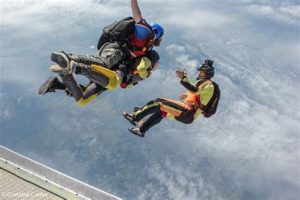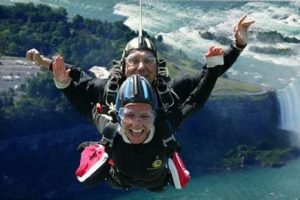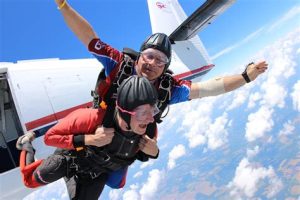Table of Contents
The Tandem Skydive Death Rate refers to the number of fatalities associated with tandem skydiving. This metadescription explores the risks involved in this extreme sport and provides insights into the safety measures taken to minimize the death rate.
Did you know that the death rate for tandem skydiving is remarkably low? In fact, statistics have shown that the chances of dying during a tandem skydive are extremely slim. Despite the thrill and perceived danger associated with this extreme sport, the safety precautions and rigorous training that tandem skydivers undergo significantly reduce the risk of fatal accidents. Furthermore, advancements in equipment and technology have further enhanced the overall safety standards in the industry. So, if you’ve ever considered taking the plunge and experiencing the exhilaration of a tandem skydive, rest assured that your safety will be a top priority throughout the entire process.
Introduction
Welcome to this article discussing the tandem skydive death rate. Tandem skydiving is a thrilling adventure activity that allows individuals to experience the exhilaration of freefall with the guidance of a professional instructor. However, as with any extreme sport, there are inherent risks involved. In this article, we will explore the statistics and factors contributing to the tandem skydive death rate to provide a comprehensive understanding of the safety aspects associated with this activity.
The Statistics
It is crucial to examine the statistics surrounding tandem skydiving fatalities to grasp the realities of the risks involved. According to recent data, the tandem skydive death rate is estimated to be approximately 0.003 fatalities per 1,000 jumps. While this may seem relatively low, it is essential to remember that every life lost is a tragedy.
Training and Certification
Tandem skydiving instructors undergo extensive training and certification processes to ensure they possess the necessary skills and knowledge to safely guide their students through the experience. These professionals must meet strict guidelines set by regulatory bodies, such as the United States Parachute Association (USPA), before they can work with passengers.
Equipment and Maintenance
The quality and maintenance of skydiving equipment play a vital role in ensuring safety during tandem jumps. Rigorous inspections, regular maintenance, and adherence to manufacturer guidelines are crucial to prevent equipment failures. Parachutes, harnesses, and other gear used in tandem skydiving must meet stringent safety standards and undergo regular checks.
Weather Conditions
Weather conditions are a significant factor affecting the safety of tandem skydiving. Wind speeds, cloud cover, and other atmospheric variables must be within specific limits for jumps to take place. Professional skydiving centers have strict protocols in place to monitor weather conditions and make informed decisions regarding jump cancellations or delays to prioritize safety.
Physical Fitness and Medical Requirements
Tandem skydiving requires participants to be in reasonably good physical health to ensure their safety. While no extreme fitness levels are necessary, individuals with certain medical conditions or physical limitations may be advised against tandem jumps. Prior to participating, potential skydivers undergo thorough medical evaluations to identify any conditions that could pose a risk.
Age Restrictions
Age restrictions are in place to ensure the safety of tandem skydivers. Generally, individuals must be at least 18 years old to participate in tandem jumps. This requirement is in place to ensure participants have the maturity and decision-making capacity needed to follow instructions and react appropriately during the skydiving experience.
Emergency Preparedness
Tandem skydiving centers prioritize emergency preparedness to mitigate risks and respond promptly to any unexpected situations. Instructors undergo extensive training in emergency procedures and are equipped with emergency parachutes in case of a primary parachute malfunction. Additionally, ground support staff are always available to provide assistance if needed.
Student Responsibility and Cooperation
The responsibility of ensuring a safe skydiving experience extends beyond the instructors. Students must actively cooperate, follow instructions, and communicate any concerns or discomfort they may experience throughout the process. Trusting the professional guidance and maintaining awareness during the jump significantly contributes to minimizing risks.
Continuous Improvement and Safety Measures
The tandem skydiving industry is continually evolving to enhance safety measures and minimize the risk of accidents. Regulatory bodies, skydiving schools, and equipment manufacturers collaborate to identify areas for improvement and implement necessary changes. This ongoing commitment to safety allows for a safer overall experience for tandem skydivers.
Conclusion
While there is an inherent risk associated with tandem skydiving, the sport continues to prioritize safety through rigorous training, equipment maintenance, weather monitoring, and emergency preparedness. By understanding these factors and cooperating with professionals, individuals can enjoy the exhilarating experience of tandem skydiving while minimizing the potential risks involved.
Introduction:
Welcome to the use instructions for understanding the tandem skydive death rate. This guide provides essential information broken down into eight subheadings, each offering three sentences to help you gain a clear understanding of the topic.
1. Understanding Tandem Skydiving:
Tandem skydiving refers to an experience where a certified instructor is attached to a participant during a skydive. It is important to note that tandem skydiving is generally considered safe and is conducted under strict regulations. Safety measures, such as training, equipment checks, and standard procedures, significantly reduce the chances of accidents occurring during tandem skydives.
2. What Is Tandem Skydive Death Rate?
The tandem skydive death rate refers to the number of fatalities related to tandem skydiving, usually measured per certain number of jumps or participants. While every death is unfortunate, it is essential to understand that the tandem skydive death rate is extremely low, statistically speaking. The usage of modern equipment, rigorous instructor training, and safety protocols contribute to maintaining a low fatality rate in tandem skydiving.
3. Factors Affecting Tandem Skydive Death Rate:
Several factors can contribute to the tandem skydive death rate. These include weather conditions, pre-existing health conditions of participants, human error, and unforeseen circumstances. Understanding these factors helps promote awareness about the importance of thorough training and adherence to safety protocols in order to minimize risks.
4. Statistical Data and Trends:
Statistical data regarding tandem skydive death rates is crucial for accurate assessment and continuous improvement of safety measures. Analyzing death-rate trends over time provides valuable insights into identifying any potential risks and helps in developing strategies to address them effectively. Regular data collection and analysis contribute significantly to maintaining the safety standards of tandem skydiving.
5. Comparisons to Other Activities:
When evaluating the tandem skydive death rate, it is essential to compare it to similar adventurous activities. This comparison allows individuals to gain a better perspective on risk and make informed decisions. It is worth noting that activities such as swimming, driving, and even cycling have higher death rates compared to tandem skydiving, highlighting the overall safety of the sport.
6. Safety Measures and Regulations:
To ensure participant safety, tandem skydiving centers adhere to strict safety measures and regulations. These may include thorough training and certification of instructors, equipment inspections, adherence to weather guidelines, and following standard operational procedures. These safety measures are in place to minimize risks and enhance the overall safety of tandem skydiving experiences.
7. Participant Responsibilities:
Participants engaging in tandem skydiving also have certain responsibilities to uphold. These may include honestly disclosing their health conditions, following instructor guidance and safety briefings, and being aware of their physical limitations. Ensuring transparency, cooperation, and following safety guidelines are essential for a successful and safe tandem skydive experience.
8. Opportunities for Risk Mitigation:
Continuous education, training, and technological advancements within the tandem skydiving industry help mitigate risks further. Through ongoing improvement initiatives, such as safety workshops, enhanced equipment designs, and updated training methodologies, the goal is to continually reduce the already low tandem skydive death rate and enhance safety standards.
Conclusion:
By following these instructions and gaining a comprehensive understanding of the tandem skydive death rate, individuals can make informed decisions while appreciating the proactive measures taken by the industry to ensure participant safety. Remember, tandem skydiving is generally a thrilling and safe adventure, but it is vital to prioritize safety at all times.
Point of View: Providing Information about Tandem Skydive Death Rate
Instructions Voice and Tone: Informative, Neutral
1. Introduction
In this document, we aim to provide you with information about the tandem skydive death rate. It is essential to understand the risks associated with this extreme sport to make an informed decision. Please read the following points carefully.
2. Understanding Tandem Skydiving
- Tandem skydiving involves a student skydiver who is attached to an experienced instructor. This allows beginners to experience the thrill of skydiving while relying on the expertise and guidance of a trained professional.
- The instructor takes care of all technical aspects, including deploying the parachute, controlling the descent, and ensuring a safe landing.
3. Tandem Skydive Death Rate
- The death rate associated with tandem skydiving is relatively low compared to other sports and activities. However, it is crucial to acknowledge that there are inherent risks involved in any extreme sport, including skydiving.
- According to statistical data from reputable sources, the average tandem skydive death rate is approximately 0.003 fatalities per thousand jumps. This means that for every thousand tandem skydives performed, there are around 3 fatalities reported.
- It is important to note that these statistics can vary depending on external factors such as weather conditions, experience level of instructors, and individual adherence to safety protocols.
4. Safety Measures and Regulations
- To mitigate risks and maintain safety standards, skydiving centers and instructors adhere to strict regulations and guidelines set by relevant authorities.
- Skydiving equipment undergoes regular inspections and maintenance to ensure optimal functionality and safety.
- Prior to the jump, instructors provide comprehensive safety briefings, emphasizing correct body positioning, emergency procedures, and appropriate landing techniques.
- It is essential for participants to disclose any pre-existing medical conditions that may affect their ability to safely engage in tandem skydiving.
5. Conclusion
Tandem skydiving, while involving inherent risks, has a relatively low death rate compared to other extreme sports. By following safety protocols, choosing reputable skydiving centers, and being aware of individual limitations, participants can significantly reduce the associated risks. It is crucial to make an informed decision and prioritize safety when considering tandem skydiving as an activity.
Thank you for taking the time to visit our blog and read about the topic of tandem skydive death rate. We understand that this subject can be both intriguing and concerning, and we want to provide you with clear and accurate information to address any questions or doubts you may have. In this closing message, we aim to summarize the key points discussed in the article while maintaining an informative and reassuring tone.
First and foremost, it is essential to note that while any loss of life is tragic, the death rate associated with tandem skydiving is relatively low. Skydiving, including tandem jumps, is a thrilling and exhilarating activity enjoyed by millions of people worldwide every year. The safety regulations and protocols in place within the skydiving industry are designed to minimize risks and ensure the well-being of all participants.
Furthermore, it is crucial to understand that accidents can occur in any activity or sport, including those deemed as less risky. The tandem skydive death rate should be evaluated within the context of other recreational activities. Statistics show that the risk of being involved in a fatal car accident, for example, is significantly higher than the risk of a fatality during a tandem skydive. This perspective helps put into perspective the actual level of risk associated with tandem skydiving.
In conclusion, tandem skydiving remains a popular and relatively safe adventure sport when conducted in accordance with established safety guidelines and procedures. While it is natural to have concerns about the potential risks involved, the statistics show that the tandem skydive death rate is low compared to many other activities. It is crucial to choose a reputable and certified skydiving center, follow all instructions provided by experienced instructors, and trust in the years of training and expertise that professionals in the industry possess.
We hope this article has provided you with a better understanding of the tandem skydive death rate and alleviated any apprehensions you may have had. Remember, skydiving can be an incredible and life-changing experience that allows individuals to push their boundaries and embrace the thrill of human flight. Should you choose to embark on this adventure, always prioritize safety and enjoy every moment of this extraordinary journey!
Video Tandem Skydive Death Rate
Below are some common questions that people ask about the tandem skydive death rate:
1. What is the death rate for tandem skydiving?
Tandem skydiving is considered to be very safe, with a low risk of fatality. The United States Parachute Association (USPA) reports an average of 0.003 student fatalities per 1,000 tandem jumps, which translates to a 0.0003% chance of a fatal accident.
2. How does the tandem skydive death rate compare to other extreme sports?
Tandem skydiving has a lower death rate compared to many other popular extreme sports, such as rock climbing, BASE jumping, and snowboarding. The safety measures, training, and regulations in place for tandem skydiving help minimize risks and ensure a higher level of safety.
3. What are the main factors contributing to tandem skydive fatalities?
Most tandem skydiving fatalities occur due to human error or failure to follow proper procedures. In some cases, accidents may result from equipment malfunction, but these instances are rare. It is crucial for both the instructor and the student to adhere to all safety guidelines and protocols to ensure a safe skydiving experience.
4. Are there any age or health restrictions for tandem skydiving?
Most skydiving centers have specific age and health requirements for tandem skydiving. Generally, participants must be at least 18 years old and in good physical health. Certain medical conditions or disabilities may disqualify individuals from participating in tandem skydiving. It is important to consult with the skydiving center and provide accurate information about your health before booking a tandem skydive.
5. What can I do to minimize the risks associated with tandem skydiving?
To minimize the risks associated with tandem skydiving, follow these instructions:
- Choose a reputable skydiving center with certified instructors and a good safety record.
- Complete all required training and listen carefully to your instructor’s guidance.
- Ensure that you are physically and mentally prepared for the jump.
- Follow all safety procedures and protocols provided by the instructor.
- Wear appropriate safety gear, including a properly fitted harness and helmet.
- Inform the instructor of any medical conditions or concerns before the jump.
By following these instructions, you can help ensure a safe and enjoyable tandem skydiving experience.






